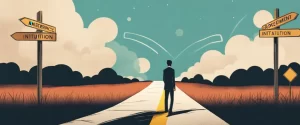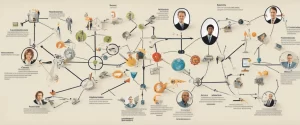——Dont Overthink It by Anne Bogel & The Change Book by Roman Tschäppeler Mikael Krogerus

In a fast-paced world brimming with countless choices and decisions, it is no wonder that the art of making choices and embracing change has become central to our lives. As we navigate the complexities of our personal, professional, and emotional spheres, we often find ourselves seeking guidance on how to make better decisions and adapt to the ever-changing landscape around us. It is within this context that we delve into the world of two remarkable books, “Don’t Overthink It” by Anne Bogel and “The Change Book” by Roman Tschäppeler and Mikael Krogerus.
At first glance, these works may appear dissimilar, as one focuses on alleviating the burden of overthinking, while the other explores the realm of change and its impact on our lives. However, delving into the pages of these insightful books, we discover overlapping themes and profound insights that connect their ideas in unexpected ways.
In Anne Bogel’s “Don’t Overthink It,” we find a compassionate and practical guide that encourages us to break free from the shackles of overthinking that often inhibit our ability to make sound decisions. Bogel dives into the complexities of our thought processes, unraveling the reasons behind our tendency to get trapped in endless cycles of analysis and doubt. With a gentle and relatable approach, she shares practical strategies and tools to quiet our minds, trust our instincts, and confidently embrace the choices we face.
On the other hand, Roman Tschäppeler and Mikael Krogerus take us on a journey through change in “The Change Book,” where they explore the various dimensions of transformation and its profound impact on our personal and professional endeavors. Through concise and thought-provoking chapters, the authors navigate an array of change-related concepts, ranging from the psychology of change to strategies for managing transitions effectively. They challenge our perception of change as an external force and instead empower us to embrace it as an inherent part of our lives, ripe with opportunities for growth and advancement.
As we embark on this comparative study of “Don’t Overthink It” and “The Change Book,” we invite you to join us in examining the intersecting themes of decision-making and adaptation. Together, we will explore how these two books complement and illuminate each other, offering us invaluable insights into the art of navigating decisions and embracing change in a world that often overwhelms us. Through this exploration, we aim to glean practical strategies and perspectives that will not only enhance our decision-making abilities but also empower us to thrive amidst the inevitable waves of change that shape our lives.
Brief Summary of Two Books
Dont Overthink It by Anne Bogel
“Don’t Overthink It” by Anne Bogel is a self-help book that explores the detrimental effects of overthinking and offers strategies to overcome this harmful habit. Bogel introduces the notion that overthinking not only wastes time and energy but also prevents individuals from experiencing a fulfilling and intentional life.
The book begins by highlighting the various ways in which overthinking manifests itself in our daily lives, such as decision-making paralysis, excessive worry, and constantly rehashing past events. Bogel explains that overthinking often stems from a fear of making mistakes or a need for control, both of which hinder personal growth and happiness. She emphasizes that overthinking is not a sign of intelligence or caring but rather a counterproductive behavior.
To combat overthinking, Bogel offers practical tips and methods. She emphasizes the importance of identifying triggers, addressing the root causes of overthinking, and practicing self-compassion. Bogel also suggests finding healthy distractions, setting boundaries with information consumption, and simplifying daily routines to reduce overwhelm.
Furthermore, the author delves into the benefits of cultivating mindfulness and gratitude, as well as the power of reframing negative thoughts. She provides a range of tools and techniques, such as journaling, breathing exercises, and seeking support from loved ones, to help readers develop a positive mindset and break free from overthinking patterns.
“Don’t Overthink It” encourages readers to let go of perfectionism, embrace uncertainty, and trust their instincts. With a blend of personal anecdotes, psychological insights, and actionable advice, Anne Bogel invites individuals to actively engage in a more present and intentional life, free from the shackles of overthinking.
The Change Book by Roman Tschäppeler Mikael Krogerus
“The Change Book” by Roman Tschäppeler and Mikael Krogerus offers a comprehensive guide to navigating and implementing change in various aspects of life. The book presents 50 concepts and techniques to understand the process of change and apply them effectively. It covers a wide range of topics, including personal growth, professional development, and societal transformations. Each concept is presented in a concise and visually engaging manner, making it easy to grasp and implement. Whether you are looking to make changes in your career, relationships, or personal habits, “The Change Book” serves as a practical resource to inspire and support successful transformations.
Comparison between Two Books

Similarities in Decision-making
There are several similarities in the approach to decision-making presented in “Don’t Overthink It” by Anne Bogel and “The Change Book” by Roman Tschäppeler and Mikael Krogerus. While the two books have different focuses, they both offer valuable insights into decision-making processes.
Firstly, both books emphasize the importance of clarity and simplicity in decision-making. Bogel emphasizes the need to avoid overthinking and to simplify decisions by breaking them down into manageable steps. Similarly, Tschäppeler and Krogerus emphasize the power of simplicity, providing tools and frameworks to simplify complex decisions and break them down into smaller, more manageable parts.
Secondly, both books acknowledge the significance of intuition and subjective factors in decision-making. Bogel encourages readers to trust their intuition and consider their gut feelings, as they often provide valuable insights that may be difficult to rationalize. Similarly, Tschäppeler and Krogerus highlight the role of emotions, personal values, and individual perspectives in shaping decision-making processes and outcomes.
Furthermore, both books emphasize the importance of gathering relevant information and considering different perspectives before making a decision. Bogel advocates for information gathering and research to ensure decisions are well-informed, while Tschäppeler and Krogerus highlight the importance of understanding the viewpoints and interests of stakeholders involved in the decision-making process.
Lastly, both books address the potential challenges and biases that can hinder effective decision-making. Bogel discusses cognitive biases and common pitfalls that lead to decision paralysis, offering strategies to overcome these obstacles. Similarly, Tschäppeler and Krogerus present various biases and cognitive traps that can cloud decision-making, encouraging readers to be aware of these tendencies and find ways to navigate around them.
In summary, both “Don’t Overthink It” and “The Change Book” emphasize the need for simplicity, trust in intuition, gathering relevant information, considering different perspectives, and being aware of biases in the decision-making process. These books provide valuable insights that can help readers make more effective decisions in various aspects of their lives.
Divergences in Decision-making
“Dont Overthink It” by Anne Bogel and “The Change Book” by Roman Tschäppeler and Mikael Krogerus are both books that touch upon decision-making but approach the subject from different angles. While “Dont Overthink It” focuses on overcoming the habit of overthinking, “The Change Book” presents various decision-making models to facilitate change. The divergence in decision-making between these books can be seen in their perspectives, strategies, and audience.
Firstly, “Dont Overthink It” takes a more personal and introspective perspective on decision-making. Anne Bogel emphasizes the negative impact of overthinking and provides strategies to overcome it. She encourages readers to trust their intuition, set boundaries, and develop a decision-making process that reduces stress and uncertainty. The book mainly targets individuals seeking to simplify their lives and gain more clarity in making choices.
On the other hand, “The Change Book” adopts a broader perspective, focusing on decision-making within the context of driving change. Roman Tschäppeler and Mikael Krogerus explore numerous decision-making models that can be utilized by organizations and individuals when navigating organizational changes, personal transformations, or societal shifts. The book aims to equip readers with tools to analyze complex situations, understand stakeholders’ perspectives, and make effective decisions towards successful change implementation.
Another divergence lies in the strategies offered by these books. “Dont Overthink It” provides practical exercises and actionable steps to break the cycle of overthinking, such as journaling and brainstorming techniques. It emphasizes the importance of self-reflection and mindset shifts to improve decision-making. Conversely, “The Change Book” offers a range of decision-making models, such as the Rational Analysis or Cost-Benefit Analysis, providing readers with structured frameworks to evaluate decisions objectively. It aims to enhance decision-making through systematic thinking rather than addressing the habit of overthinking specifically.
Lastly, the audience they target contributes to the divergence in decision-making. “Dont Overthink It” is primarily tailored for individuals who tend to ruminate excessively and need guidance to simplify their decision-making processes. It focuses on personal growth and provides relatable examples from everyday life. On the other hand, “The Change Book” is intended for professionals leading or navigating organizational changes, individuals seeking personal development through transformative decision-making, or those interested in the theories and practices of change management.
In conclusion, “Dont Overthink It” and “The Change Book” diverge in their approaches to decision-making. While both touch on the subject, the former concentrates on overcoming overthinking through personal reflection and mindset shifts, primarily targeting individuals. In contrast, the latter provides decision-making models for effectively driving change, addressing a wider scope including organizational transformations and personal development.

Conclusion
Both “Don’t Overthink It” by Anne Bogel and “The Change Book” by Roman Tschäppeler and Mikael Krogerus are highly regarded books in their respective fields. As such, the worthiness of reading each book can depend on individual preferences and needs.
“Don’t Overthink It” by Anne Bogel is focused on helping readers overcome the tendency to overanalyze and overthink various aspects of their lives. The book offers practical advice and strategies to reduce overthinking and make decisions more effectively. If you find yourself constantly overthinking and seeking methods to simplify your thought process and decision-making, this book may be more worthy of reading.
On the other hand, “The Change Book” by Roman Tschäppeler and Mikael Krogerus is a guide that presents 50 models explaining various aspects of change, ranging from personal development to organizational transformations. This book offers a broad perspective on change and may be beneficial for those interested in understanding and managing change in different contexts.
In the end, consider your personal interests, goals, and preferences when deciding which book is more worthy of reading for you.



